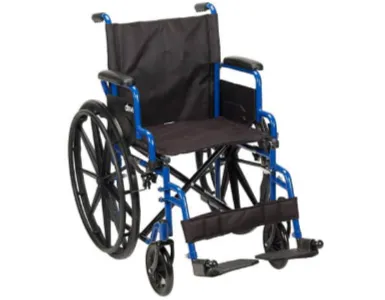Can mobility scooters go up hills?
Once my father tried climbing a steep road slope with his scooter but ended up with an exhausted battery and had to use public transport to return home.
I rolled my sleeves and did my homework on steep hills and electric scooters to avoid any future accidents.
And I’m going to share my findings with you and help you figure out what slopes your mobility scooter can climb.
FYI, this post contains affiliate links. I may earn a commission at no extra cost to you.
Table of Contents
Quick Summary
- Some mobility scooters can climb steep hills, but others can handle only gentle slopes.
- Scooters, power chairs, and wheelchairs can climb ramps and curbs.
- The motor power and weight are the key factors that determine how well your scooter can climb steeper hills.
Can Mobility Scooters Go Up Hills?
Some mobility scooters can go up hills with moderate slopes. Other models are designed to handle off-road or challenging terrains so that steeper hills won’t be much of a problem.

It all depends on your scooter’s type – the maximum slope angle it can handle and whether it has a powerful motor and the right rear suspension for steep terrain.
So, if you’re using a mobility aid and living in an area with steep inclines, you’d be right to worry about your vehicle going up hills without rolling down or losing battery power.
Manufacturers provide information about the scooter’s maximum slope gradient and road usability in the user’s manual. All you have to do is read it carefully or contact the manufacturer.
Still, I’ll give you a word of caution. Manufacturers extensively test their products to determine their maximum slopes, speed, etc. However, these tests are done in perfect conditions.
And when you’re braving hilly terrains, the conditions are rarely perfect. Your mobility scooter can underperform in the most extreme of conditions and not match the manufacturer’s specifications.
On the other hand, some powerful scooters can perform better than the recommended manufacturer’s specifications when going up challenging streets.
But forcing your vehicle up challenging hills can damage the motor and the battery charge, especially if you’re an inexperienced rider.
So, what’s the maximum hill grade for mobility scooters? Let’s talk about gradient and how it determines your scooter’s hill-climbing ability.
What’s the Maximum Slope for Mobility Scooters?
As experts from RIDS explain, “All scooters have a ‘maximum gradient,’ the steepest slope that they can safely be used on.” (1)
Most models have a maximum incline range of 6 to 8 degrees so that they can handle mild to moderate slopes and gentle inclines.
However, some powerful off-road mobility scooters have an incline range of up to 10-12 degrees, making them an excellent choice for steeper areas.
Remember that some high-performance bikes, electric scooters, and cars can’t overcome the steepest slopes. So don’t expect miracles, especially from budget scooters.
But what about wheelchair ramps? If some mobility aids have trouble climbing slopes, you’d be right tor about whether you can count on them up a wheelchair ramp.
Can Mobility Scooters Climb Up a Wheelchair Ramp?
As experts from BraunAbility explain,
“The commercial and public facility standard for slope is 1:12 (in inches) or about 5 degrees of incline.” (2)
So, since most mobility scooters have an average incline of 6 degrees, they can handle the gentle slope and climb up wheelchair ramps with no issues.

Still, some ramps are designed with a slope of 1:8 for assisted use, and this steep slope can be too much for some models.
And what about curbs? How well do scooters handle curbs? Let’s find out!
Can Mobility Scooters Climb Curbs?
Most four-wheel mobility scooters do well with curbs. You just have to approach the curb head-on, not at an angle.
Three-wheel models are more unstable and likely to tip over. So, it’s better to attempt curb climbing with someone to steady you.
And how fast can a mobility scooter go? You’d be surprised!
What’s the Max Speed of Mobility Scooters?
Most mobility scooters have a maximum speed of four mph. But scooters in the high-performance category can have the insane speed of 18 miles per hour.
And it’s possible to get an extra boost in some models by removing the speed limiter, upgrading to powerful batteries, or activating the power mode.
Still, it’s unlikely you’d be able to achieve such an extreme speed going up steep hills. But your vehicle will be much faster on the way down. Ensure you’ve got good brakes to prevent accidents on the way down.
And before you try riding your scooter as fast as the wind, keep in mind the speed limit.
According to UK regulations, the maximum speed is four mph off-road and eight mph on the road. USA states also have laws regarding mobility scooters and whether they’re allowed on the road. (3)
Now, let’s talk about what features to consider if you want a scooter with great hill-climbing ability.
Be sure to check out our article on “Are Mobility Scooters Allowed on Public Transport?” for comprehensive information on this topic.
What Features to Consider Before Trying to Go Up Hills with a Mobility Scooter?
A few key features determine how successful you’d be in trying to climb a steep slope with a mobility scooter.
The most important ones are the powerful motor, its torque, and the combined weight of the scooter and the rider. The tires and the type of suspension matter to a lesser degree.
You should also keep the batteries in mind. You’ll see why in a bit.
1. Combined Weight
Most mobility scooters have a maximum weight capacity of 250-350 pounds. But the heaviest scooters can handle 400 pounds and more, thanks to their robust frame.
Calculate the combined weight of the scooter, its riders, and any additional weight (often, scooters come with plenty of accessories that increase the total weight).
Then check the maximum weight capacity of your vehicle because it won’t achieve maximum performance if you’re over the limit.
Moreover, the heavier the weight, the more resistance, and the harder it will be to climb hilly terrains. That’s why lighter riders don’t have as many issues with hill climbing as heavier ones.
So, if you’re having issues with gentle slopes, get rid of any additional weight, such as the storage basket.
2. Powerful Motor
The power output of the motor matters when tacking challenging hills. The more motor power, the more torque it can produce, allowing it to rotate the wheels better and overcome steep inclines.
For example, an electric scooter with a 250-watts motor should have no issues up a 6-degree hill grade. But it’ll struggle if you force it to go up 10-degree slopes.
And models with dual motors will have extra torque, allowing you to travel up extreme hill accents.
3. Types of Tyres
As an experienced rider, I know the tires also matter when you’re getting scooters up hills or climbing steeper slopes.
Larger wheels are better for climbing challenging slopes because they provide better traction and don’t allow the wheels to spin.

The biggest tires range from 8″ to 13″, so you’ve got plenty of options if you want excellent traction on drastic slopes.
4. Suspension
Responsive suspension is another standout feature of the perfect scooter for going uphills. Suspension determines how well-balanced your mobility vehicle is at an angle.
A simple suspension system will shift the weight towards the back when you’re on a hill grade, making it harder and more uncomfortable to travel up hills.
5. Battery Life
Your scooter can go several miles on a single charge, but the scooter batteries run empty when going up steep slopes. Why?
The scooter batteries don’t determine your vehicle’s hill-climbing ability. But traveling up challenging hills requires more power and extra torque, draining battery power.
Upgrading to more powerful batteries or a larger battery pack can ensure you won’t have to stop and recharge your vehicle when going up the hills.
And what are the top mobility scooters for riding challenging streets and drastic slopes? Let’s find out!
What Are the Best Mobility Scooters for Going Up Hill?
When looking for a scooter that performs well in the most extreme of conditions, you need a vehicle with a heavy-duty frame and greater than the average incline rating.
1. AFIKIM Afiscooter S4 Mobility Scooter
The Afiscooter has an 11.3-degree incline rating and awesome motor power, so you won’t have trouble with gentle slopes or extreme hill accents. Its large wheels also provide decent traction on hill rides.
It’s also the perfect scooter for heavy riders since its monstrous frame can withstand up to 500 pounds (600 pounds if you upgrade).
2 . Red Elephant Heavy-Duty Mobility Scooter

This Red Elephant mobility scooter has a remarkable hill-climbing ability, thanks to an incline rating of 12 to 15 degrees (depends on weight and battery charge).
It also has impressive motor power, can reach an extreme speed of 15 mph, and travel up to 48 miles on a single charge.
This heavy-ish scooter also has many key features to ensure rider comfort, including LED lights. Check the in this video.
3. Pride Victory LX Sport

The Pride Victory isn’t one of the best extreme performance scooters, but it has an impressive incline rating of up to 8 degrees, a sturdy frame, and a powerful motor.
It provides good traction on hill rides or road slopes, while the impressive motor power allows you to reach up to eight mph. And you can travel up to 19.7 miles on a single charge.
Check out more about this sport scooter in this video.
FAQs
How Steep an Incline Can a Mobility Scooter Climb?
On average, mobility electric scooters have a six to eight degrees maximum incline range. But extreme performance scooters have an incline range of up to 12 degrees, perfect for steep hill rides.
Can Electric Wheelchairs Go Uphill?
Yes, some power chairs can go up hills. But it depends on their incline range, motor power, and how powerful the battery pack is.
Do Mobility Scooters Tip Over?
Yes, electric scooters can tip over, especially on extreme hill accents. But most models are stable on gentle slopes, as long as you aren’t an aggressive rider who loves extreme speed.
Can Mobility Scooters Go on Gravel?

Yes, mobility scooters are designed to handle different types of surfaces, including gravel. But some perform better on gentle slopes and surfaces than on looser terrain.
How Long Do Mobility Batteries Last?
Most batteries last up to an hour on a single charge. However, your batteries will drain faster when going up hills because you need more power to overcome the steep terrain.
Conclusion
Can mobility scooters go up hills? Yes, some can handle drastic slopes and challenging streets, thanks to their awesome power, great incline rating, large tires, and powerful batteries.
But for your ease of mind, ask the manufacturer about the maximum incline your scooter can handle, especially if you live in a city with steeper slopes.

Can your mobility scooter go up hills? Share your thoughts in the comment section.
Resources:
- 1. Mobility scooters stability | RiDC [Internet]. www.ridc.org.uk. Available from: https://www.ridc.org.uk/features-reviews/out-and-about/choosing-wheelchair/mobility-scooters/mobility-scooters-stability
- 2. Wheelchair Ramp Slope | ADA Compliance [Internet]. BraunAbility. Available from: https://www.braunability.com/us/en/blog/disability-rights/wheelchair-ramp-slope.html
- 3. Rules for users of powered wheelchairs and mobility scooters (36 to 46) – The Highway Code – Guidance – GOV.UK [Internet]. www.gov.uk. Available from: https://www.gov.uk/guidance/the-highway-code/rules-for-users-of-powered-wheelchairs-and-mobility-scooters-36-to-46





